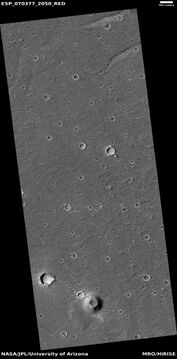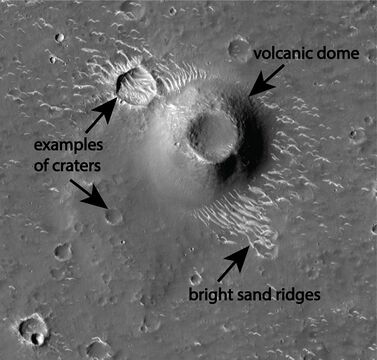Difference between revisions of "Zhurong"
m |
m |
||
| Line 11: | Line 11: | ||
</gallery> | </gallery> | ||
| − | Research published in May, 2022 described chemical evidence for water discovered by the Zhurong Rover. Hydrated sulfate/silica materials were identified on the Amazonian-age terrain at the landing site. These hydrated minerals were found in bright-toned rocks. Authors of the research interpreted these minerals to be from a "duricrust." The duricrust was formed either by groundwater rising or subsurface ice melting. This duricrust was created just under the surface,and then was uncovered by erosion. Finding these minerals here suggests that water may have been present at later times then thought. Perhaps liquid water appeared after impacts or from hot magma under the surface. We know there is much ice under the surface and any heat might melt it and then the water could carry dissolved | + | Research published in May, 2022 described chemical evidence for water discovered by the Zhurong Rover. Hydrated sulfate/silica materials were identified on the Amazonian-age terrain at the landing site. These hydrated minerals were found in bright-toned rocks. Authors of the research interpreted these minerals to be from a "duricrust." The duricrust was formed either by groundwater rising or subsurface ice melting. This duricrust was created just under the surface,and then was uncovered by erosion. Finding these minerals here suggests that water may have been present at later times then thought. Perhaps liquid water appeared after impacts or from hot magma under the surface. We know there is much ice under the surface and any heat might melt it and then the water could carry dissolved minerals around. The minerals could then be deposited when water evaporated.<ref>https://www.science.org/doi/10.1126/sciadv.abn8555</ref> <ref>Liu, Y., et al. 2022. Zhurong reveals recent aqueous activities in Utopia Planitia, Mars. Science Advances. VOL. 8, NO. 19</ref> |
== References == | == References == | ||
Revision as of 07:59, 13 May 2022
Zhurong is a six-wheeled rover built by China. It landed on Mars in the area called Utopia Planitia on May 14, 2021. Zhurong is about the size of NASA's twin Mars rovers Spirit and Opportunity. It has six scientific instruments, including two panoramic cameras, a ground-penetrating radar and a magnetic field detector. Like America's Curiosity and Perseverance Martian rovers, Zhurong has a laser to zap rocks and thereby study their compositions.[1]
Research published in May, 2022 described chemical evidence for water discovered by the Zhurong Rover. Hydrated sulfate/silica materials were identified on the Amazonian-age terrain at the landing site. These hydrated minerals were found in bright-toned rocks. Authors of the research interpreted these minerals to be from a "duricrust." The duricrust was formed either by groundwater rising or subsurface ice melting. This duricrust was created just under the surface,and then was uncovered by erosion. Finding these minerals here suggests that water may have been present at later times then thought. Perhaps liquid water appeared after impacts or from hot magma under the surface. We know there is much ice under the surface and any heat might melt it and then the water could carry dissolved minerals around. The minerals could then be deposited when water evaporated.[2] [3]
References
- ↑ https://www.space.com/china-mars-rover-landing-success-tianwen-1-zhurong
- ↑ https://www.science.org/doi/10.1126/sciadv.abn8555
- ↑ Liu, Y., et al. 2022. Zhurong reveals recent aqueous activities in Utopia Planitia, Mars. Science Advances. VOL. 8, NO. 19









